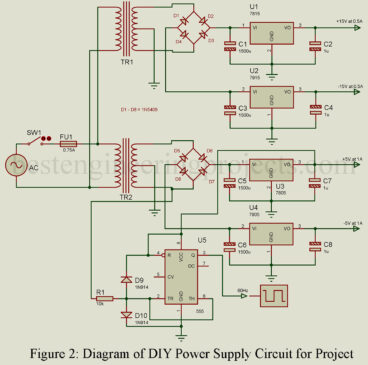Introduction Accurate timekeeping is crucial for electronics and IoT projects. A Real-Time Clock (RTC) is essential for maintaining precise time, especially during power outages. However, more than relying solely on the RTC module might be required for long-term projects due to drift over time. This is where Network Time Protocol (NTP) comes in. By synchronizing the RTC with an internet time server, you can ensure that your system stays perfectly in sync, regardless of how long it runs. In this guide, we’ll show you how to set up a Real-Time…
Read MoreCategory: Electronics Projects
Multi-Switch Relay Control with EX-OR Gates
Many electronics enthusiasts love to design their custom control circuits. Today, we’re exploring an interesting circuit that accomplishes single relay control through multiple switches. This circuit accomplishes this achievement and introduces the utilization of EX-OR gates within control systems. Check out the article on “How to make relay switch circuit” Before we delve into the circuit’s details, let’s first understand what an EX-OR gate is. Exclusive OR Gate An exclusive OR gate, often abbreviated as EX-OR performs the following logic “The output of a 2-input Exclusive OR gate assumes the…
Read MoreSimple Intruder Alarm Circuit
In a world where safety and security are a major concern, imagine having a reliable intruder alarm system that can offer peace of mind. Here is a simple intruder alarm circuit that does not need a deeper understanding of electronics. These homemade security solutions are cost-effective also. So, if you are a DIY enthusiast or just curious about creating your own security setup. Here is a customized intruder alarm circuit that suits your needs perfectly. Let’s dive into its description and working methodology. Circuit Description of Intruder Alarm Circuit The…
Read MoreExploring the ICL8038: Building an Audio Function Generator Circuit
Introduction: In the world of electronics, different types of waveforms are essential for testing various circuits. A sine wave signal is commonly used for assessing linear circuits such as amplifiers and filters. In contrast, a square wave input becomes crucial when testing digital circuits like flip-flops, counters, and registers. In this article, we’ll delve into constructing and operating an audio function generator utilizing the specialized integrated circuit, ICL8038. Notably, this audio function generator circuit offers not only sine and square waves but also triangle waves. Circuit Description and Operation of…
Read MoreMaking Your Own Dual-Tone Doorbell Circuit Diagram
Imagine opening the door to a gentle ding-dong sound that evokes the charm of classic electric bells. With our simple tutorial, you can create a simple yet attractive dual-tone doorbell circuit diagram that generates this lovely sound. Let’s plunge into the details of the circuit. Description of Dual-Tone Doorbell Circuit Diagram Our inventive dual-tone doorbell circuit diagram is assembled around the versatile IC CD40106, also known as a hex Schmitt-trigger inverter (referred to as U1). For precise triggering and to prevent any unintended activations, we’ve cleverly integrated an R-C filter…
Read MoreHow to: AC Voltage Measurement using Arduino without Transformer
In electronics, Arduino has reshaped how we tinker with technology. Voltage measurement is a core aspect, but dealing with AC voltage adds complexity, especially without a transformer. Usually, transformers isolate high AC voltages for measurement. But when space or components are limited, Arduino offers an alternative. In this article, we’ll unravel measuring AC voltage using Arduino without the bulky transformer. Component Requirements for AC Voltage Measurement using Arduino without Transformer Arduino Board x 1 Grove- AC Voltage Sensor x 1 I2C LCD x 1 Circuit Description of AC Voltage Measurement…
Read MoreBuilding a Programmable Touch Power Supply Circuit
Today, many gadgets use touch control – a simple touch makes things happen and adds a modern touch. People who enjoy electronics are creating their power supplies with LM317 variable IC regulators and special switches for power adjustments. There’s a cool project here called the “Programmable Touch Power Supply Circuit” It’s not just a regular power supply – it has touch magic. You can change settings by touching it, mixing tech with simplicity. Imagine devices without buttons – this project uses touch sensors. No searching for buttons – just touch…
Read MoreOptimizing Speaker Performance with Woofer and Tweeter Matcher Circuit
Discover how a woofer and tweeter matcher circuit enhances audio systems by producing balanced sound. Learn how specialized components optimize low and high frequencies, leading to an enjoyable listening experience. Introduction: A speaker’s frequency response plays a crucial role in delivering high-quality sound across the audible spectrum. However, not all speakers can reproduce frequencies uniformly, leading to an imbalanced sound output. To overcome this challenge, audio systems incorporate specialized components known as woofers and tweeters, each optimized for handling specific frequency ranges. Woofer and Tweeter Function: Woofer: A woofer is…
Read MoreHow to Design Power Supply for Electronics Systems
Introduction to Power Supply for Electronics Systems A power supply plays a crucial role in the functioning of electronic systems. Most digital integrated circuits (ICs) require a ±5V supply, while linear ICs such as op-amps and special-purpose ICs need ±15V supplies. In this article, we will discuss a power supply that provides ±5V and ±15V outputs. The Power Supply Circuit: The block diagram of a typical power supply is illustrated in Figure 1. Figure 2 presents the schematic diagram of the power supply, designed to deliver an output voltage of…
Read MoreFrequency Shift Keying Demodulator Circuit
Frequency Shift Keying (FSK) plays a significant role in the field of computer peripheral and wireless communication, facilitating the transmission of binary data or code. This technique involves the manipulation of a carrier frequency, which undergoes precise shifts between two pre-established frequencies. The utilization of FSK allows for efficient and reliable data transfer. Description of Frequency Shift Keying Demodulator Circuit An area where FSK finds particular utility is in demodulating signals, and the 565 phase-locked loop (PLL) serves as an excellent tool for FSK demodulation. In this context, a binary…
Read More








